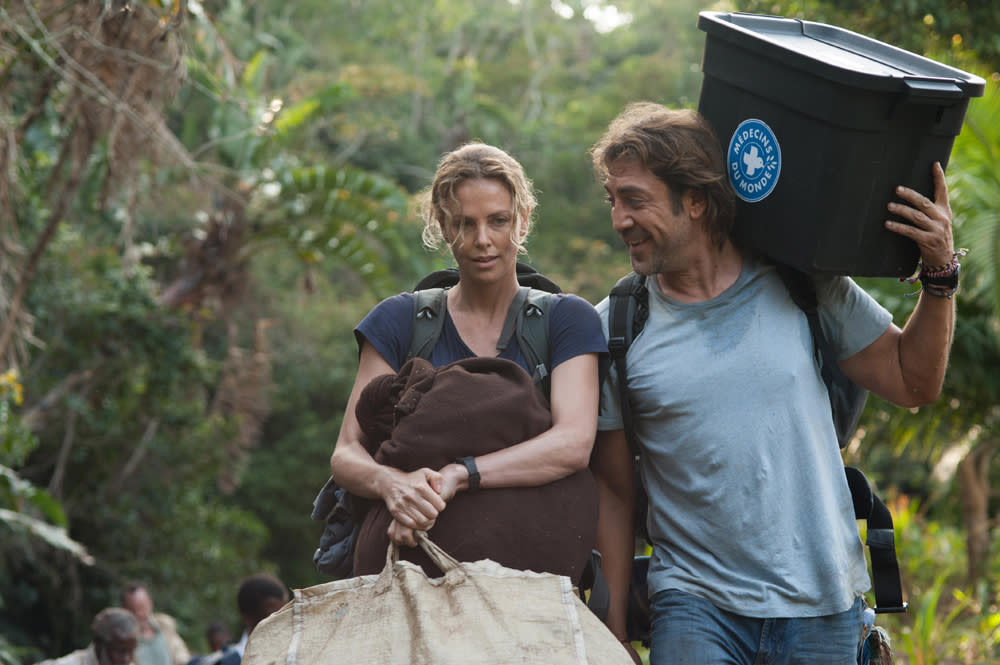Cannes Film Review: ‘The Last Face’

Last year, “Beasts of No Nation” told a story of mutilated innocence in an unnamed African hell zone, but it didn’t feel compelled to add a token white hero (the caring photojournalist! the conflicted U.N. peacekeeper!) for the audience to identify with. “The Last Face,” an endless, logy cataclysm of a war-torn political drama directed by Sean Penn, goes right back to the look!-here-are-some-movie-stars-in-the-maelstrom paradigm. The film is set in some of the most blood-soaked territories of Africa – South Sudan, the Sierra Leone, Liberia — and it’s full of jaggedly edited sequences in which children lie on operating tables with their chests blown open, corpses appear in fly-buzzing piles and homemade bombs and machine-gun fire explode out of nowhere at deafening volume. At the front and center, though, are two characters who are in the crisis but not of it: Charlize Theron as Wren Petersen, a globe-trotting physician and activist, and Javier Bardem as Miguel Leon, a surgeon to refugees who lives his life in a state of triage. These two meet in Liberia in 2003, fall into an affair, argue about whether they love each other, and then break up (not necessarily in that order). “The Last Face” is Sean Penn’s version of an Angelina Jolie movie: It keeps advertising its compassion, yet it’s really a drama about two beautiful movie stars trying to save the world. Who, after all, can’t identify with that?
The last film that Penn directed, “Into the Wild” (2007), was an aesthetic breakthrough for him: It had a rhythmic and visual freedom that his earlier films (“The Pledge,” “The Crossing Guard”) didn’t, and a subtler humanity as well. But between that film and this one, Penn starred in Terrence Malick’s masterpiece of lyric memory, “The Tree of Life,” and it would appear that the Malick touch has now exerted a major influence on him, and not in a good way. These days, if an independent film includes one artful shot of a wheat field that lingers for more than four seconds, the filmmaker will inevitably be hailed as “a new Terrence Malick,” but the Malick influence is not, by and large, something to celebrate. (If you look at his recent films, even Malick is too influenced by Malick.) “The Last Face,” at heart, is a straightforward drama (or should have been), but Penn stages it as a needlessly fragmented and dreamy art poem. There are no establishing shots, so the handheld vérité stuff leaves the spatial dynamics of each setting a bit vague, and the whole film is stitched together by voiceover, with Wren and Miguel pouring out their overly mournful thoughts to us.
Take, for instance, the issue of why Wren does what she does. She leads an organization called Doctors of the World, which was created by her late father, and this is her way of attempting to live up to his legacy. But wait: When she’s in the chaos of a war zone, administering aid to children, she feels closer to her father, but also trumped by him, as if she herself were invisible. We know all this — essentially, the entire rather muddled inner life of the character — because Charlize Theron tells it to us, with limpid and repetitive dismay, on the soundtrack. The repetitions are a Malick tic: hidden emotions turned into incantatory motifs. Or, at least, that’s what Penn seems to think he’s doing. But “The Last Face” would have been a better movie if it had an actual screenplay, rather than the bare-bones one credited to Erin Dignam.
Wren gets pulled into Miguel’s orbit in the middle of the night, on the road, when he’s delivering an African baby with a desperate last-minute C-section. Afterwards, she looks at Miguel, and he’s shaggy and suave, devoted to all the right things, and she, with her buttoned-up daddy issues, is just waiting to let her hair down. The film’s conflict, as presented, is this: Though he burns with the desire to save lives, Miguel is something of a player. Wren learns that he was carrying on an affair with her associate volunteer (played by Adèle Exarchopoulos, from “Blue is the Warmest Color”), and it scalds her. Yet the Miguel we see is tender, devoted and often heartsick. It’s hard to resist the interpretation that he’s Sean Penn’s rather self-flattering stand-in: a stud of compassion.
Technically speaking, “The Last Face” is often an impressive achievement. Penn is a gifted filmmaker who doesn’t sugarcoat the horror of what he’s out to show us. The medical scenes are often brutal, not so much because of the wounds or the blood but because we’re watching children die. The message hits home, because really, how could it not? Yet Penn would do well not to mistake his own global caring for an artistic impulse. “The Last Face” was greeted with jeers at its Cannes press screening, and that’s because no matter how “well-meaning” a director may be, there’s something inherently eye-rolling about being asked to care about the tragedy of African children through the POV of two lovelorn glamourpusses. If you really take the message of the movie to heart, it just forces you to acknowledge that the story — to quote Humphrey Bogart — doesn’t amount to a hill of beans.
Related stories
Sean Penn Responds to Negative Reviews for 'The Last Face': 'I Stand by the Film'
Sean Penn's 'The Last Face' Ripped Apart on Twitter After Cannes Debut
Cannes Is Low on American Indie Filmmakers, But That's OK
Get more from Variety and Variety411: Follow us on Twitter, Facebook, Newsletter
